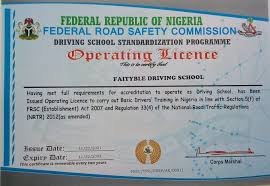Establishing a certified driving school in Nigeria is a strategic move for entrepreneurs aiming to contribute to road safety and driver education. The Federal Road Safety Corps (FRSC), through its Driving School Standardisation Programme (DSSP), ensures that driving schools meet the necessary standards to operate legally and effectively. This guide provides a step-by-step approach to obtaining a driving school certification, detailing requirements, procedures, costs, and common misconceptions.
1. Understanding the Driving School Standardisation Programme (DSSP)
The DSSP is an initiative by the FRSC to regulate and standardise driving schools across Nigeria. The program aims to:
-
Ensure uniformity in driver education.
-
Enhance road safety through quality training.
-
Provide legal recognition to driving schools that meet established standards.
Certified driving schools are authorised to engage in driver education and training activities, contributing to the reduction of road traffic crashes.
2. Minimum Technical Requirements for Certification
Before applying for certification, prospective driving school proprietors must fulfill the following compulsory technical requirements:
| Requirement | Description |
|---|---|
| CAC Certificate of Incorporation | Proof of legal business registration. |
| Classroom/Administrative Office | A designated space for theoretical training sessions. |
| Roadworthy Vehicle(s) for Driving Instructions | Dual-control vehicles suitable for practical driving lessons. |
| Licensed Driving Instructor(s) | Instructors with valid FRSC certification. |
| Course Manual | Official training materials approved by FRSC. |
| Highway Code | The official document outlining road traffic laws. |
| Traffic Laws/Regulations Handbook | A comprehensive guide on traffic regulations. |
| First-aid Facilities | Basic medical supplies for emergency situations. |
| Fire Extinguisher | Equipment to handle fire emergencies. |
| Open-space Driving Range | A designated area for practical driving exercises. |
| Computer/Mobile Device with Internet Capabilities | For administrative tasks and online resources. |
Additional recommended requirements include:
-
Simulator/Mock Vehicle
-
Road Signs Models
-
Vision Acuity Test Facilities
-
Library
-
Inspection Pit/Workshop
-
Television and CD Player
-
Overhead Projector
-
Magnetic Board
-
Safety Tips Handbook
These additional facilities enhance the quality of training and ensure comprehensive driver education.
3. Certification Process and Procedure
The process of obtaining a driving school certification involves several steps:
Step 1: Visit Nearest FRSC Office
Prospective proprietors should visit the nearest FRSC office to initiate the certification process.
Step 2: Obtain Registration Form TSC 0001a
After ensuring that the minimum technical requirements are met, obtain the registration form TSC 0001a from the training officer.
Step 3: Complete and Submit Form
Fill out the registration form accurately and return it to the FRSC office.
Step 4: Preliminary Inspection
The state committee on DSSP, led by the training officer, conducts a preliminary inspection of the driving school at an agreed date, with the proprietor in attendance.
Step 5: Report Submission
The report of the preliminary inspection, signed by the sector commander, is forwarded through the supervisory FRSC zonal office to the training department at the FRSC national headquarters.
Step 6: Assessment and Approval
The training department profiles the proposed driving school for further inspection and assessment. If the assessment results are favourable, the head of the training department recommends approval to the Corps Marshal.
Step 7: Issuance of Certificate
Upon approval, the FRSC issues a certificate of operation to the driving school, authorising it to commence legal operations.
Step 8: Commencement of Operations
The certified driving school may now legally engage in driver education and training activities.
4. Certification Levels and Grading
After inspection and assessment, driving schools are classified based on their facilities and adherence to standards:
| Certification Level | Grade | Score Range |
|---|---|---|
| Full Certification | A | 90% – 100% |
| Certification | B | 80% – 89% |
| Certification | C | 70% – 79% |
| Provisional Certification | D | 60% – 69% |
| Provisional Certification | E | 50% – 59% |
| Not Certified | F | Below 50% |
Schools that compromise the minimum uniform standards set by the FRSC may have their certification suspended or withdrawn.
5. Costs and Fees
While specific fee structures are not detailed on the official DSSP website, prospective proprietors should contact their nearest FRSC office for the most accurate and up-to-date information regarding certification fees and other associated costs.
6. Common Misconceptions
-
“I can operate without certification if I have a CAC registration.”
False. CAC registration does not replace FRSC certification. Operating without FRSC certification is illegal and may lead to penalties. -
“The certification process is quick and easy.”
False. The process involves multiple steps, including inspections and assessments, which can take time. -
“Once certified, no further requirements are needed.”
False. Certified driving schools must adhere to ongoing standards and may be subject to periodic inspections.
7. Frequently Asked Questions (FAQs)
Q1: How long does the certification process take?
A1: The duration varies depending on the preparedness of the driving school and the availability of FRSC officers for inspections. It is advisable to plan for several weeks to complete the process.
Q2: Can I operate a driving school without certified instructors?
A2: No. All instructors must be licensed by the FRSC to ensure standardised and quality training.
Q3: Are there any ongoing requirements after certification?
A3: Yes. Certified driving schools must adhere to the FRSC’s standards and may be subject to periodic inspections to ensure compliance.
8. Conclusion
Obtaining a driving school certification in Nigeria is a structured process overseen by the FRSC to ensure quality driver education and road safety. By meeting the required standards and following the outlined procedures, prospective proprietors can establish legally recognised driving schools that contribute positively to road safety in Nigeria.
For more detailed information and to begin the certification process, visit the official DSSP website.


